 The Brahmaputra River is one of the most significant confidence-building measures between India, China, and Bangladesh. Despite a well-functioned relationship between India and China in recent decades.
The Brahmaputra River is one of the most significant confidence-building measures between India, China, and Bangladesh. Despite a well-functioned relationship between India and China in recent decades.
The Brahmaputra River may pose new challenges to the continued supply of fresh water for both countries in the future. In addition, China’s announcement, last month, of its plans to construct three hydropower dams – Dagu, Jiacha, and Jiexy along the middle reaches of the Brahmaputra basin, has raged anxiety in India and Bangladesh in terms of erosion, flood protective measures, and the potential ecological damage to the downstream regions.
The article delves into a strategic-techno analysis of the issues festering around the proposed dam construction projects that may open a new front of contentious politics amongst the neighbours. It examines whether ‘water rationality’ will continue to govern the riparian relationship, and also reasons that in spite of no water sharing agreement between India and China, vis-à-vis only one water treaty between India and Bangladesh; coupled with the enormous potential of sharing the benefits, it is unlikely to envision the three countries agreeing to sign a portioned water resource development treaty in the near future.
Fresh Strategic Insights: Issues and Steps
The Brahmaputra River consolidated the water rights between all the riparian states pertaining to their water usage, and requirements in the growing region. In spite of there having being no official water sharing accord between India and China, the two countries manifest a paradigm to maintaining cordial water diplomacy in the present international scenario of water conflicts. Hitherto, the dilemma over future water supply regulations, amidst the issue of ecological upkeep, persists for both India and Bangladesh.
China's vigorous push in favour of the hydropower base construction on the Brahmaputra or Yarlung Zangbo River (as known in China) is foreseen as an attempt to harm the downstream interests, particularly of Northeast India. The construction of the 100 meters Zangmu dam (510 MW project) in the Tibet Autonomous Region (TAR) in 2010, is an approximate case in point. The current proposed construction of the 124 metres Dagu dam, which has a 640 MW capacity, triggers a maximum impact on the downstream flows in India. Post the ‘flurry of dam-building’, China has tried to leverage its hydropower requirements in the north and central regions; however, India’s Northeast, and neighbouring Bangladesh could face an undeniably reduced water supply, if not for acute water shortage. This is reasoned since the watercourse feeds on seven rivulets originating from the glaciers in the Tibetan plateau, hence damming the river upstream could result in the lower riparian regions facing an intense water division from these snow-fed rivulets during the summer months.
While the run-of-the-river projects are, primarily, meant to store large volumes of water for generating power, fresh concerns were raised regarding the need for a scientifically designed drainage system all over the downstream region, complemented by extensive soil conservation, afforestation, and watershed management in the hilly areas of the Northeast region. An in-depth study of the climatic changes that cause erratic flooding patterns is urged so that proper ameliorative measures may be adopted. This, combined with regional flood early warning systems and flood moderation measures, along with well-planned erosion management, should encourage inter-state and regional cooperation. An earnest step would be for the international community and water boards to thwart any measures that are detrimental to the sustainability of the Brahmaputra. It is imperative to maintain the flow of water in the Brahmaputra River so that it can sustain the environment and water balance in India’s Northeast, Bangladesh, and Bhutan, before dispersing into the Bay of Bengal.
The Relationship Souffle
China’s aggressive planning to provide for the energy and water needs of its 1.3 billion people at the expanse of its Asian counterparts is presumable. China’s 26 other dam projects in the pipeline (also along the Brahmaputra River) specifies an 85 per cent decline in flows from China to India during the summer months. Even if the foreseen water depictions, such as an environmental imbalance, natural disasters, degraded fragile ecologies, and diversion of vital river resources were to be refuted, China could keep any riparian neighbour on good behaviour by acquiring the capability of using the Brahmaputra as a political instrument.
Thus, the implications for setting up an International Brahmaputra River Water Tribunal for arriving at an international water treaty, or a preliminary initiative of a tripartite agreement between India, China, and Bangladesh to sustain passive relations in the region deem vital. But envisaging a portioned water resource development treaty between the three countries is unlikely, where issues related to trade, transit, land, roadway, and, water distribution first require a heads up between the three neighbouring states. China’s growing strategic interests in Pakistan, Southeast Asia, and maritime security coupled by Tibet’s invasion in the past, raise grave security concerns for India with its plan to divert waters of the Brahmaputra to north and central China. For India, the middle riparian between China and Bangladesh, marks a fine exemplar to understanding the water needs vis-à-vis water supplies, as it swings around both sides of the table. As a result, whether water rationality will continually govern riparian relations still remains a question mark.
Courtesy : Institute of Peace and Conflict Studies (http://www.ipcs.org)